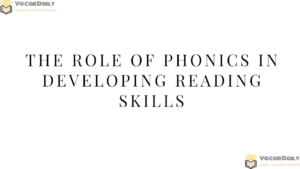The Role of Phonics in Developing Reading Skills
Phonics plays a fundamental role in teaching children how to read. By focusing on the relationship between sounds and their corresponding letters, phonics provides the building blocks for reading fluency and comprehension. This article explores the importance of phonics in developing reading skills and outlines strategies for effective phonics instruction.
Understanding Phonics and Its Benefits
Phonics is the method of teaching reading by correlating sounds (phonemes) with letters or groups of letters (graphemes). This approach helps learners decode unfamiliar words, making reading less daunting. Phonics instruction equips children with the tools to recognize patterns, enabling them to read independently and with confidence.
The benefits of phonics extend beyond decoding. Research shows that phonics improves spelling, enhances vocabulary acquisition, and boosts reading comprehension. By mastering phonics, children develop a strong foundation for lifelong literacy.
Types of Phonics Instruction
There are several approaches to phonics instruction, each tailored to meet the needs of diverse learners:
- Synthetic Phonics: Focuses on teaching children to blend individual sounds to form words. For example, combining /c/, /a/, and /t/ to read “cat.”
- Analytic Phonics: Involves teaching children to recognize word patterns and larger units of sound, such as rhymes or prefixes.
- Embedded Phonics: Integrates phonics instruction into meaningful reading and writing activities rather than isolated drills.
Effective phonics programs often combine these methods, ensuring a comprehensive approach to reading instruction.
Incorporating Phonics in Early Education
Early education is a crucial period for phonics instruction. Introducing letter-sound relationships through engaging activities like songs, rhymes, and games captures young learners’ attention and fosters curiosity. Teachers can use manipulatives such as magnetic letters or flashcards to reinforce letter recognition and phonemic awareness.
Interactive storytime sessions that emphasize phonics elements, such as repeating rhyming words or highlighting consonant blends, make learning enjoyable and memorable. Pairing phonics lessons with rich literature ensures a balanced approach to literacy development.
Phonics for Struggling Readers
Phonics is especially beneficial for struggling readers. Structured, explicit instruction helps identify and address gaps in phonemic awareness and decoding skills. Diagnostic tools, such as phonics assessments, enable educators to customize lessons for individual needs.
Programs that incorporate multisensory activities—such as tracing letters in sand, clapping out syllables, or using phonics apps—engage multiple senses, reinforcing learning for children with diverse learning styles.
The Integration of Technology in Phonics Learning
Technology offers innovative tools for phonics instruction. Educational apps, interactive e-books, and online games provide engaging ways to practice phonics skills. Many programs include features such as voice recognition and instant feedback, allowing children to refine their pronunciation and improve accuracy.
While technology enhances learning, it should complement rather than replace traditional phonics instruction. Balancing screen time with hands-on activities ensures a holistic approach to literacy development.
For additional resources on phonics and reading development, visit VocabDaily. Check out the VocabDaily Workbook for exercises designed to strengthen phonics and reading skills.


Leave a Reply